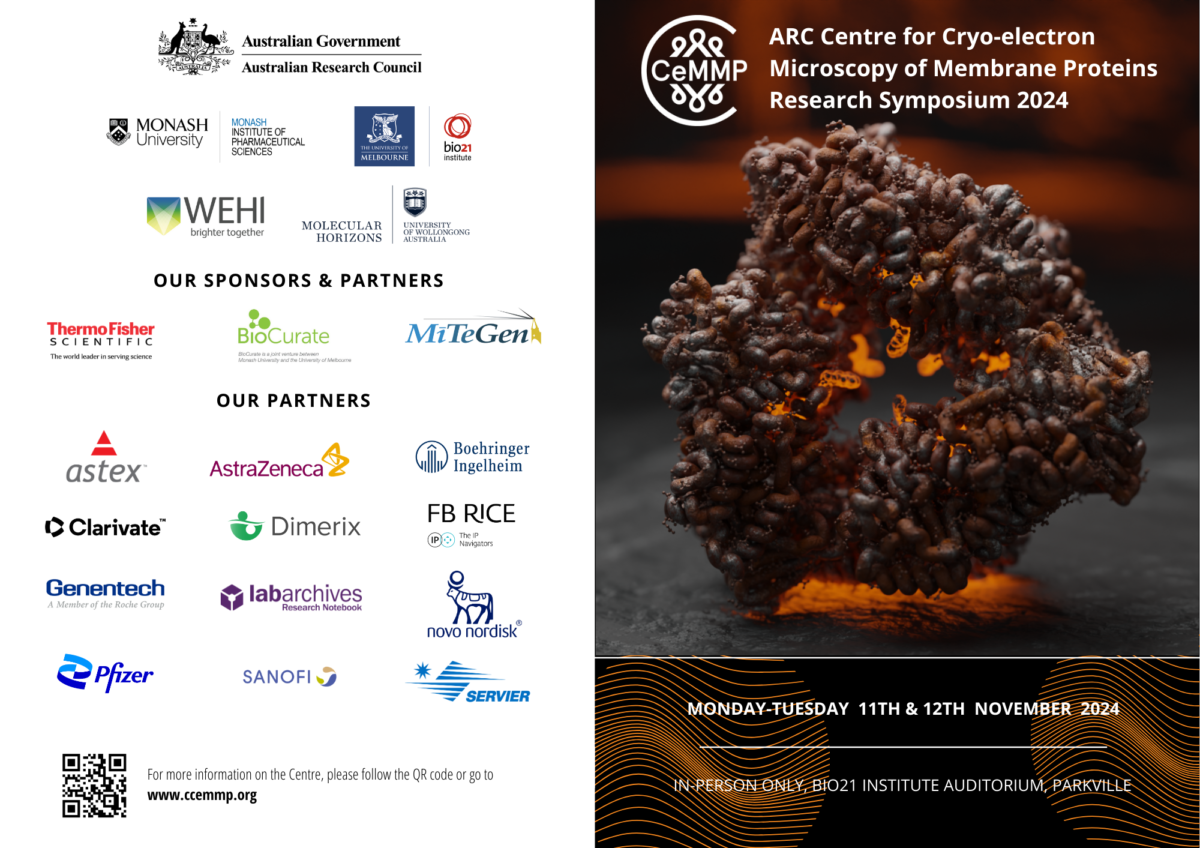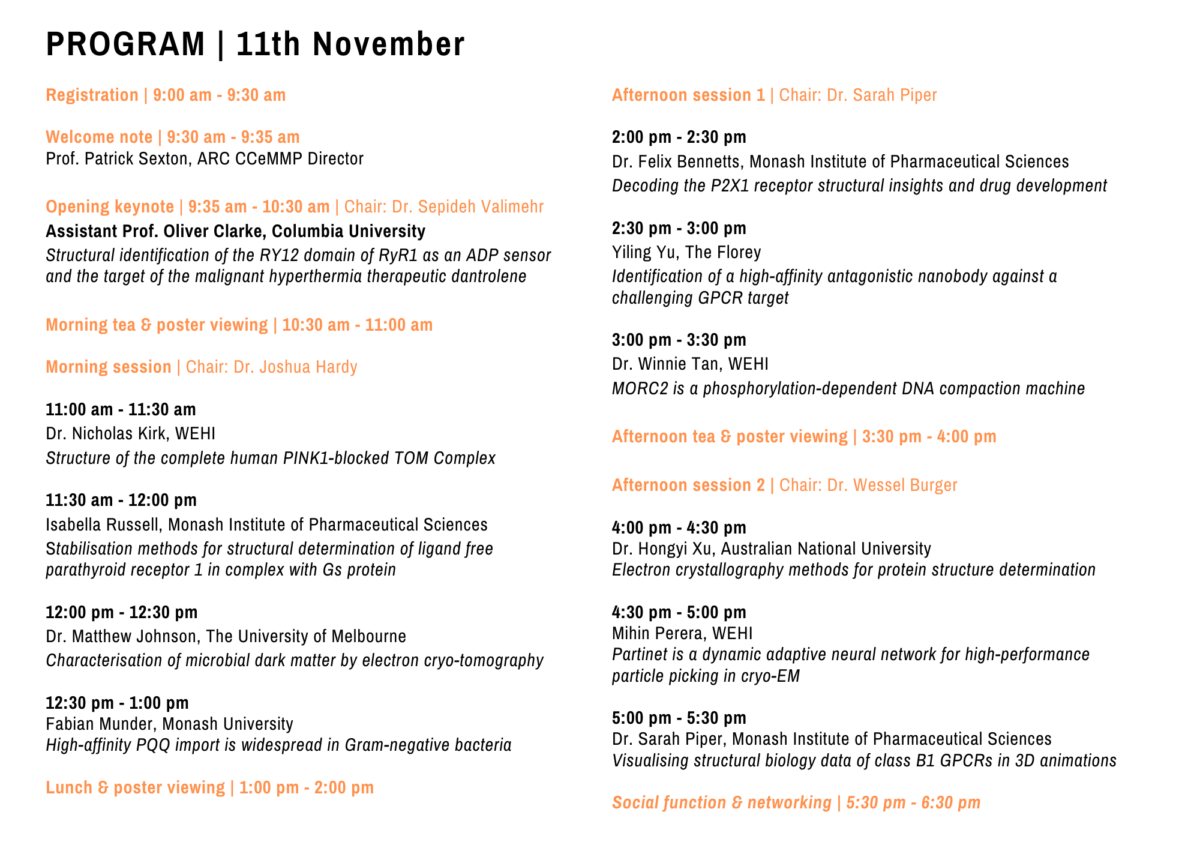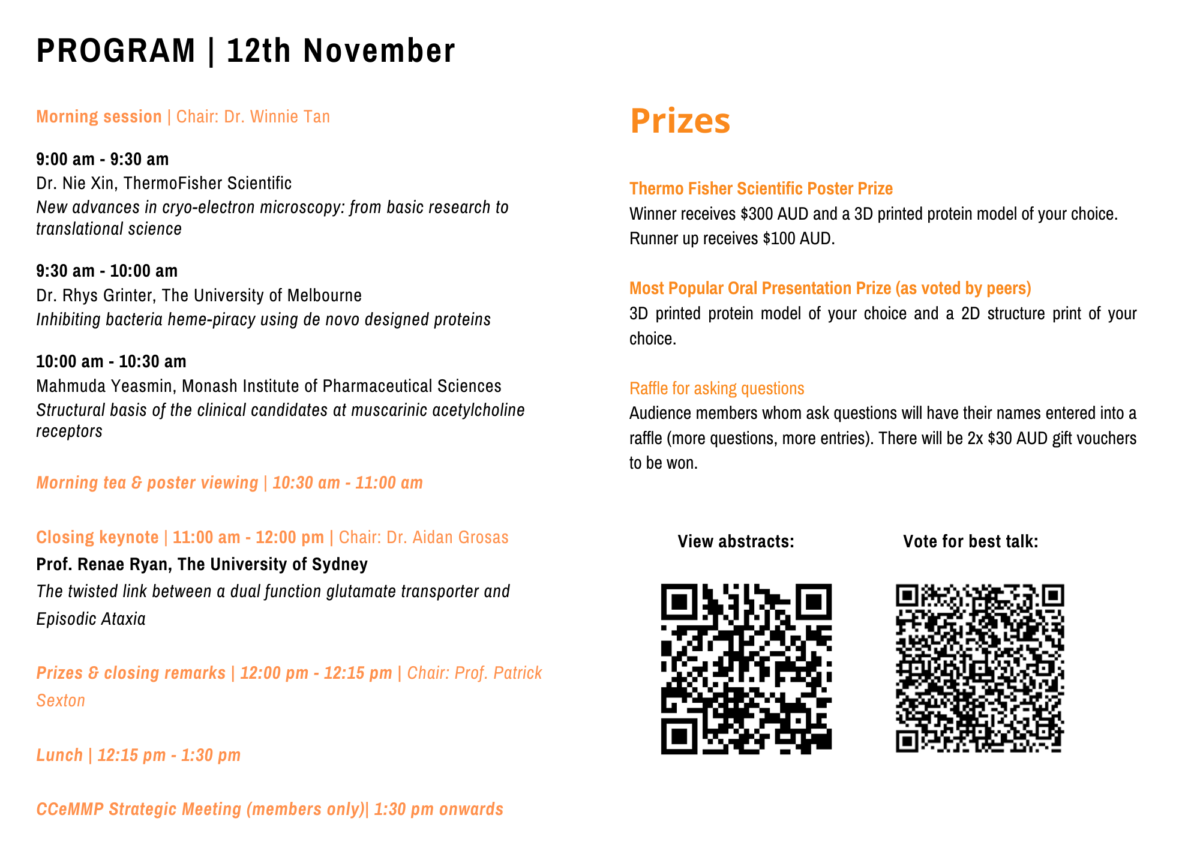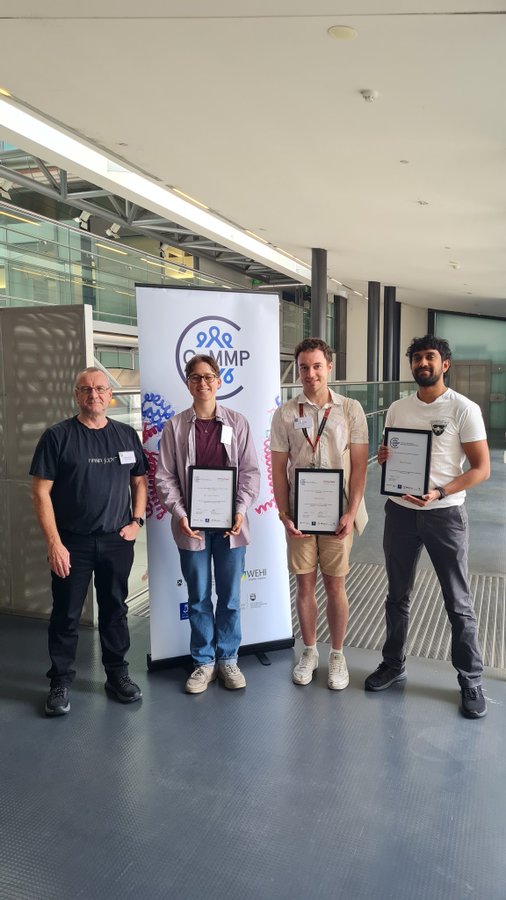ARC CCeMMP Research Symposium 2024
Registrations closed on 6 Nov, 2024Date11 Nov - 12 Nov 2024
Time 9:00 AM - 6:30 PM on 11 Nov, 9:00 AM - 12:00 PM on 12 Nov AEDT
Location Bio21 Molecular Science & Biotechnology Institute 30 Flemington Rd, Parkville, VIC 2052, Australia
The Australian Research Council funded Centre, Centre for Cryo-electron Microscopy of Membrane Proteins (CCeMMP), hosted a free in-person 2024 Research Symposium to showcase the exciting research and technological advances in the field of cryo-electron microscopy and membrane proteins and featured keynote presentations from both academia and industry. CCeMMP invited the scientific community to attend and participate in the symposium on the 11th and 12th of November, 2024, in Melbourne, Australia.
This year, CCeMMP are excited to welcome two keynote speakers and our industry partner, presenting their cutting edge research.

Professor Renae Ryan
Renae Ryan is a Professor of Biochemical Pharmacology at the University of Sydney, Australia. She received her PhD from the University of Sydney in 2004 and completed postdoctoral work with at Columbia University and the National Institutes of Health (NINDS). Renae returned to the University of Sydney in 2007 where she leads a research team that investigates the molecular mechanisms of neurotransmitter and amino acid transporters and their role in cancer and neurological diseases, such as episodic ataxia. She has received several awards for scientific excellence, mentoring and outreach including the Nancy Millis Medal from the Australian Academy of Science and the Australian Museum Eureka Prize for Mentoring of Young Researchers. Renae is a globally respected leader and advocate for gender equity, diversity and inclusion, and a sought-after supervisor, mentor, and role model for women in science.
The twisted link between a dual function glutamate transporter and Episodic Ataxia
Excitatory Amino Acid Transporters (EAATs) regulate excitatory neurotransmission by transporting glutamate into cells, mostly glia, to terminate neurotransmission and to avoid neurotoxicity. EAATs also conduct chloride ions (Cl–) via a channel-like process that is thermodynamically uncoupled from transport. The molecular mechanisms that allow these dual-function transporters to carry out two seemingly contradictory roles, and the physiological role of Cl– conductance of the EAATs, are not clear. I will describe the cryo-electron microscopy structure of a glutamate transporter homologue in an open-channel state, revealing an aqueous-accessible Cl– permeation pathway that is formed during the transport cycle and discuss the impact of a series of mutations in EAAT1 that have been identified in patients with the neurological disease episodic ataxia type 6 (EA6). By studying EAAT1 function and using a Drosophila melanogaster model of locomotor behaviour, our results indicate that mutations that lead to functional glutamate transport but either increased OR decreased Cl– channel activity contribute to the pathology of EA6, highlighting the importance of Cl– homeostasis in glial cells for proper central nervous system function. Our findings provide insight into the mechanism by which glutamate transporters support their dual functions and provides a framework for the rational development of therapeutics that can differentially modulate substrate transport or channel properties for the treatment of neurological disorders caused by EAAT dysfunction, such as Episodic Ataxia.

Assistant Professor Oliver Clarke
Oliver Clarke is an assistant professor at Columbia University, in the departments of anesthesiology and physiology. He earned his PhD from the Walter and Eliza Hall Institute, focusing on membrane protein crystallography under the mentorship of Dr. Jacqui Gulbis and Dr. Brian Smith. Moving to New York, he mastered single particle cryoEM in the lab of Wayne Hendrickson, using cryoEM to understand the architecture and gating mechanism of the skeletal muscle ryanodine receptor (RyR1). His laboratory employs structural and functional approaches to dissect complex molecular machines, with a particular focus on membrane proteins. Current research areas include the modulation of the ryanodine receptor by therapeutics and endogenous ligands, and the mechanism of ankyrin-mediated membrane protein clustering and its role in controlling cellular shape and membrane curvature.
Structural identification of the RY12 domain of RyR1 as an ADP sensor and the target of the malignant hyperthermia therapeutic dantrolene
Malignant hyperthermia (MH) is a life-threatening pharmacogenetic condition triggered by volatile anesthetics, which activate pathogenic RyR1 mutants. The small molecule therapeutic dantrolene has long been used to treat MH. However, the binding site and mechanism of dantrolene remain unclear. Here, we present cryo-EM structures of RyR1 bound to dantrolene and the MH trigger agent 4-chloro-m-cresol (4CmC), revealing the dantrolene and 4CmC binding sites in atomic detail.Strikingly, in the absence of dantrolene, this site selectively binds two ADP molecules, suggesting a possible role in ATP/ADP ratio sensing.

Doctor Nie Xin
Dr. Nie is a Life Science Product Specialist at Thermofisher Scientific, specializing in Cryo Electron Microscopy (CryoEM) workflow applications, including single particle analysis, Cryo tomography, and Micro-Electron Diffraction. With extensive experience in CryoEM, Dr. Nie has successfully assisted various customers across APAC. Based in Singapore, Dr. Nie is responsible for driving Thermo Fisher’s life sciences electron microscopy business development and growth in APAC for academia and pharma. Before joining Thermofisher Scientific, Dr. Nie worked as a research scientist at the National University of Singapore and Temasek Lifescience Laboratory, focusing on in vivo chromatin organization using CryoEM and molecular approaches.
New Advances in Cryo-Electron Microscopy: From Basic Research to Translational Science
Cryo-electron microscopy (Cryo-EM) continues to transform structural biology, particularly in the study of membrane proteins. This talk will highlight recent technological advancements in Cryo-EM workflows, featuring innovations such as the Tundra with Falcon C camera, Glacios 2, and Hydra Bio, alongside software updates like EPU, Tomo 5, and Tomo Live.
The Tundra with Falcon C camera and Glacios 2 enhance high-resolution imaging and automation, while Hydra Bio optimizes sample preparation. EPU improves automated data acquisition and Tomo 5 and Tomo Live enable advanced 3D reconstructions in real-time.
These advancements significantly enhance the precision and efficiency of Cryo-EM, driving forward both basic and translational research in membrane protein studies. Join us to explore how these tools are accelerating discoveries in structural biology and their potential impact on future scientific breakthroughs.
Program



The PDF version of the program is available here.
Oral Presentation Abstracts
Dr. Nicholas Kirk, The Walter and Eliza Hall Institute
Structure of the complete human PINK1-blocked TOM Complex
Isabella Russell, Monash Institute of Pharmaceutical Sciences
Dr. Matthew Johnson, The University of Melbourne
Characterisation of microbial dark matter by electron cryo-tomography
Fabian Munder, Monash University
High-affinity PQQ import is widespread in Gram-negative bacteria
Dr. Felix Bennetts, Monash Institute of Pharmaceutical Sciences
Decoding the P2X1 receptor structural insights and drug development
Yiling Yu, The Florey
Identification of a high-affinity antagonistic nanobody against a challenging GPCR target
Dr. Winnie Tan, The Walter and Eliza Hall Institute
MORC2 is a phosphorylation-dependent DNA compaction machine
Dr. Hongyi Xu, Australian National University
Electron crystallography methods for protein structure determination
Mihin Perera, The Walter and Eliza Hall Institute
Partinet is a dynamic adaptive neural network for high-performance particle picking in cryo-EM
Dr. Sarah Piper, Monash Institute of Pharmaceutical Sciences
Visualising structural biology data of class B1 GPCRs in 3D animations
Dr. Rhys Grinter, The University of Melbourne
Inhibiting bacteria heme-piracy using de novo designed proteins
Mahmuda Yeasmin, Monash Institute of Pharmaceutical Sciences
Structural basis of the clinical candidates at muscarinic acetylcholine receptors
Poster Presentation Abstracts
Alok Pradhan, Monash Institute of Pharmaceutical Sciences
Structure determination of GPCR heteromers
Ania Beyger, Monash Institute of Pharmaceutical Sciences
The structural and pharmacological characterization of CXCR3 isoforms
Bhavika Rana, Monash Institute of Pharmaceutical Sciences
Dr. Brian Cary, Monash Institute of Pharmaceutical Sciences
Bronte Caroll, University of Sydney
Brooke Hayes, Monash University
Aiming to kill: Rhs effector delivery by the Type VI Secretion System
Daniel Fox, Bio21 and The University of Melbourne
AI-Designed Protein Inhibitors can block heme uptake and inhibit growth of Pathogenic E. coli
David Safadi, University of Wollongong
Structure and function of the GABAB receptor upon the binding and activation by analgesic peptides
Dr. Debnath Ghosal, Bio21 and The University of Melbourne
Understanding the infection cycles of membrane-containing phages at molecular resolution
Dongju Lee, Monash Institute of Pharmaceutical Sciences
Structural and pharmacological insights into orphan GPCR, GPR151 with G protein couplings
Haripriya Ramakrishnan, The Walter and Eliza Hall Institute
Inamur Rahman, Bio21 and The University of Melbourne
Destroying the human immunodeficiency virus before infection
Jack Tovey, Monash Institute of Pharmaceutical Sciences
Cryo-EM to determine the structure of CCK1R in complex with SR146131
James Davies, University of Wollongong
Structure of the human carnitine transporter
Javaid Jabbar, Bio21 and The University of Melbourne
Kenta Ishii, Monash Institute of Pharmaceutical Sciences
Luca Troman, Bio21 and The University of Melbourne
Single particle cryo-EM analysis of spirochete periplasmic flagella
MariaKatarina Lambourne, University of Wollongong
Marialena Georgopoulou, Bio21 and The University of Melbourne
Mayada Mazher, Bio21 and The University of Melbourne
Studying The potential of TMEM120A membrane protein as a voltage gated Ion channel
Michaela Kaoullas, Monash Institute of Pharmaceutical Sciences
Structural Insights into Positive Allosteric Modulation at the M4 muscarinic acetylcholine receptor
Milad Reyhani, Bio21 and The University of Melbourne
Characterization of a large protein complex in Nanobdellota archaeon YN1
Minakshi Baruah, Monash Institute of Pharmaceutical Sciences
Determination of antagonist-bound vasopressin receptor structures by cryo-electron microscopy
Qinghao Ou, Monash Institute of Pharmaceutical Sciences
Structural understanding of tirzepatide on GIPR and GLP-1R
Riya Joseph, Bio21 and The University of Melbourne
Shubha Udupa, Bio21 and The University of Melbourne
Visualizing the structure and dynamics of the horizontal gene transfer during bacterial conjugation
Solace Roche, University of Queensland
Evidence for the mechanism of pore-formation of an ABC toxin
Somavally Dalvi, Bio21 and The University of Melbourne
Susovan Das, The Walter and Eliza Hall Institute
Structural Insight Into G Protein Coupling And Activation Of Human Frizzled Receptors
Theodore Nettleton, Monash Institute of Pharmaceutical Sciences
Cryo-EM structures and HDX-MS data of PAC1R splice isoforms in different states of activation
Tiffany Myint, The Florey
Relaxin Receptor (RXFP1) in Focus: Structural Insights into Activation
Xiaomin Wang, The Walter and Eliza Hall Institute
SARS-CoV-2 co-receptors: What they do and how they do it?
Yi Zeng, University of Sydney
The ins and outs of transport and inhibition of Organic Cation Transporter 1
Prize Winners
- Thermo Fisher Scientific Poster Prize – Daniel Fox (UoM/Monash) ($300 and a 3D printed model)
- Thermo Fisher Scientific Poster Prize Runners-Up – Dr. Luca Troman (UoM) ($100)
- Most Popular Oral Presentation Prize (voted by peers) – Mihin Perera (WEHI) (3D printed protein model and a 2D structure print )

Sponsors
This event is generously sponsored by BioCurate, MiTeGen and Thermo Fisher Scientific.
Organising Committee
2024 Symposium Committee Members
Dr. Sepideh Valimehr, Bio21 and The University of Melbourne
Dr. Wessel Burger, The Walter and Eliza Hall Institute
Dr. Winnie Tan, The Walter and Eliza Hall Institute
Emily Park, The Walter and Eliza Hall Institute
Xiaomin Wang, The Walter and Eliza Hall Institute
Riya Joseph, Bio21 and The University of Melbourne
Supported by Dr. Tracie Pierce and Dr. Jackie How, Monash University
